Top 10 Workfront Alternatives for Agencies (2025)
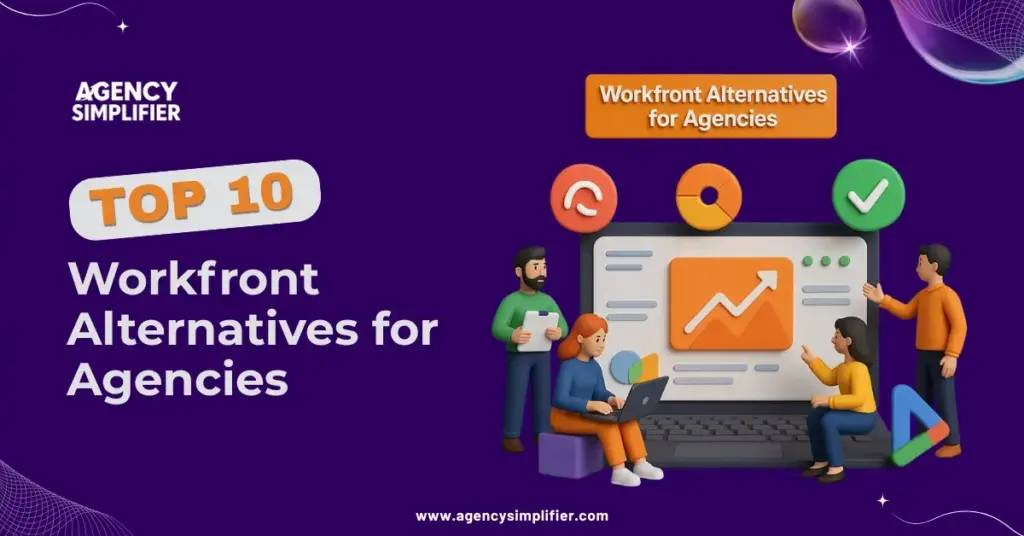
Project management software is essential for agencies juggling multiple clients, deadlines, and teams. Adobe Workfront remains a popular choice, but it isn’t always the best fit. Many agencies find Workfront expensive, hard to customize, and challenging to integrate with their existing tools.
This guide compares the top 10 Workfront alternatives for 2025, helping you find a platform that’s easier to use, more affordable, and better suited to your agency’s needs.
Where Workfront Falls Short for Agencies
- High Total Cost of Ownership: Workfront’s pricing can be steep, especially as your agency grows or needs more features.
- Steep Learning Curve: Teams often struggle with onboarding and daily use due to Workfront’s complexity.
- Limited Flexibility: Creative and marketing agencies may find Workfront’s workflows too rigid for their processes.
- Integration Challenges: Workfront doesn’t always play well with other agency tools, leading to manual workarounds.
- Customization Constraints: The platform can feel limiting if you want to tailor it to your agency’s unique needs.
- Scalability Issues: As your agency grows or specializes, Workfront may not scale as smoothly as you’d like.
Why Consider Workfront Alternatives?
Agencies want tools that are simple to use, cost-effective, and designed for their unique workflows. Many alternatives offer better value, faster onboarding, and more flexible integrations. Modern platforms also bring improved automation, reporting, and collaboration features—making it easier to stay organized and deliver for your clients.
Key Features to Look for in Workfront Alternatives
- User-Friendly Interface: Easy for teams to learn and use daily.
- Flexible Project & Resource Management: Adapts to your agency’s workflow and scales as you grow.
- Seamless Integrations: Connects smoothly with your CRM, accounting, and creative tools.
- Transparent, Scalable Pricing: No hidden fees or surprise costs as your team expands.
- Advanced Reporting & Automation: Real-time dashboards, automated workflows, and robust analytics.
Top 10 Workfront Alternatives for Agencies in 2025
Below are some of the leading project management tools agencies consider as alternatives to Workfront. Each platform has unique strengths and may suit different agency needs.
1. Agency Simplifier
About: Agency Simplifier is designed specifically for agencies, focusing on simplifying project and resource management while integrating client collaboration and financial workflows.
Key Features:
- End-to-end project and resource management
- Automated client onboarding and billing
- Customizable reporting and dashboards
- Integration with popular agency tools
- Scalable for agencies of all sizes
Who It’s For: Agencies looking for a solution built around their specific workflows and growth needs. It balances ease of use with powerful features tailored for agencies.
Let’s take a closer look at Agency Simplifier’s standout features.
End-to-End Project and Resource Management
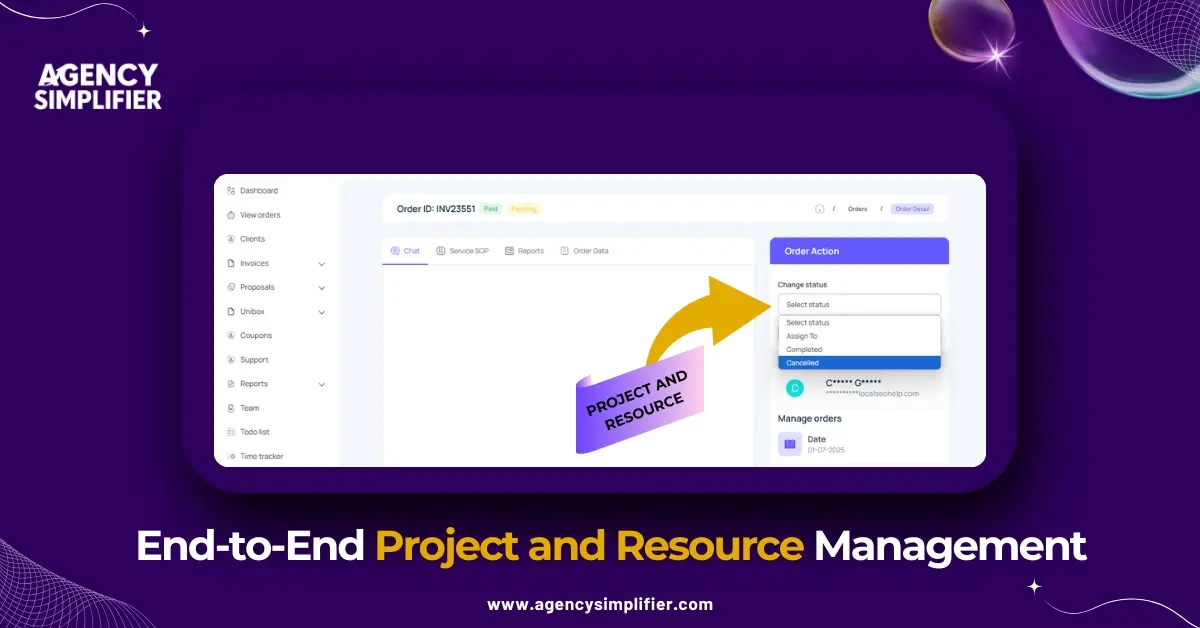
Agency Simplifier streamlines every stage of your agency’s workflow, from project kickoff to final delivery. With intuitive project boards, task assignments, and milestone tracking, your team always knows what’s next and who’s responsible. This clarity helps you hit deadlines and keep projects moving, even when you’re juggling multiple clients.
Resource management is built in, so you can easily see team availability, balance workloads, and allocate tasks based on skill sets. This means fewer bottlenecks, less burnout, and a smoother path to project completion. You get a real-time view of capacity, helping you plan ahead and optimize your team’s productivity.
Automated Client Onboarding and Billing
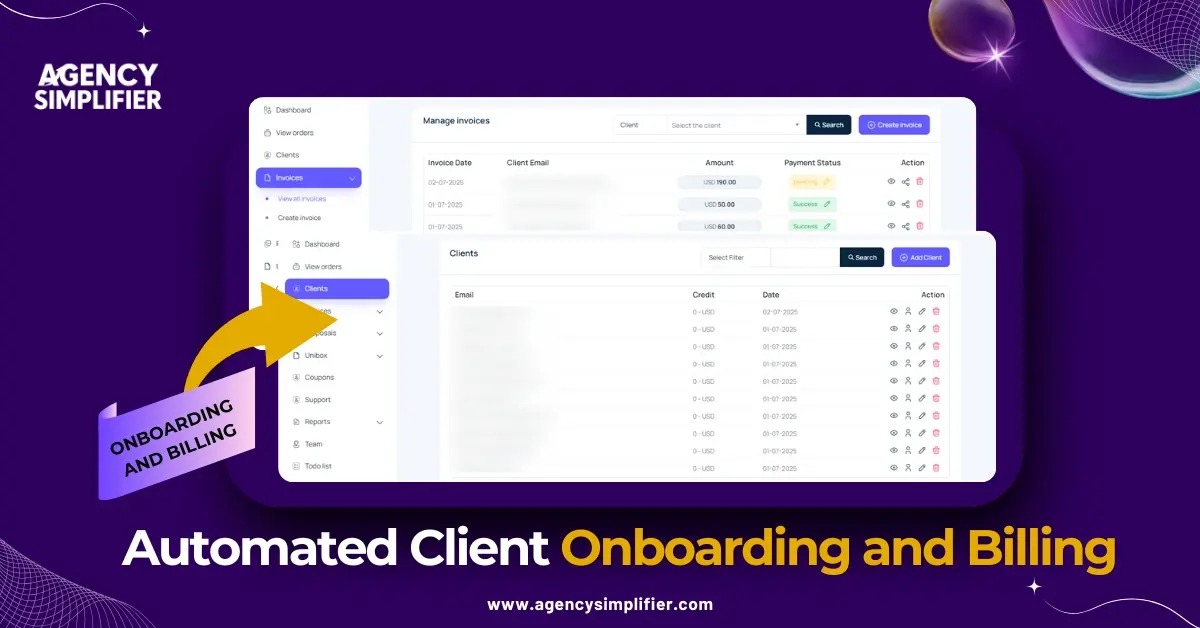
Onboarding new clients is often a pain point for agencies, but Agency Simplifier automates the process from the first handshake to the first invoice. You can set up onboarding workflows, collect client information, and automatically generate contracts and welcome emails—all from one platform.
Billing is just as seamless. The system tracks billable hours, generates invoices, and even sends automated payment reminders. This reduces manual work, speeds up cash flow, and ensures nothing slips through the cracks. Your team spends less time on admin and more time delivering value to clients.
Customizable Reporting and Dashboards
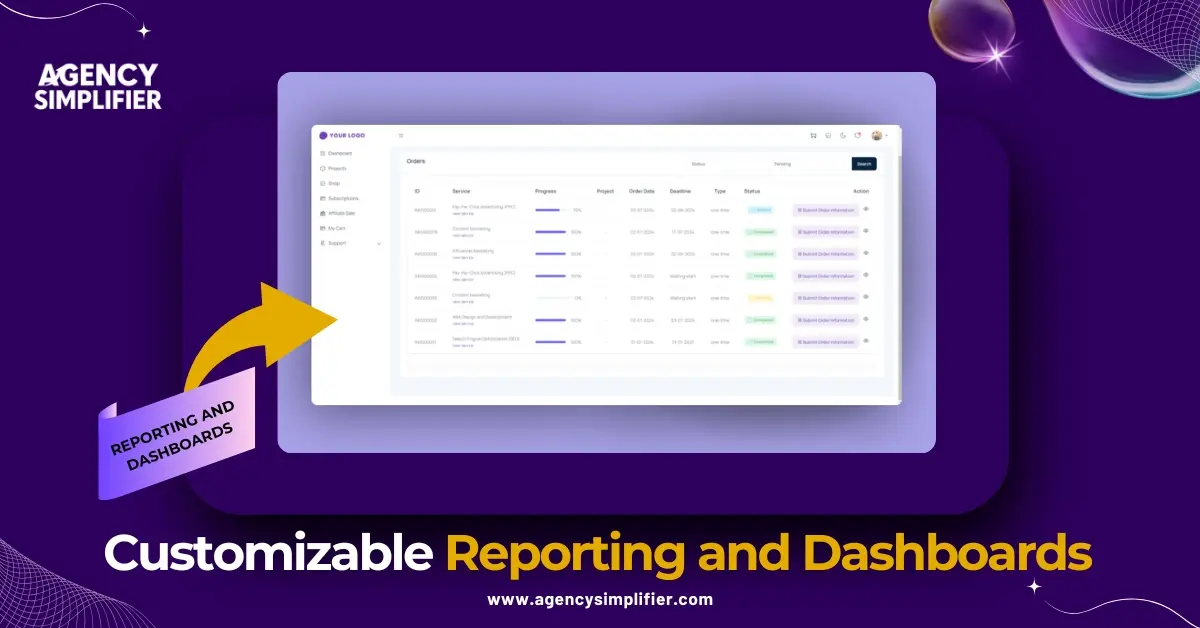
With Agency Simplifier, you can build dashboards that show exactly what matters to your agency. Choose from a range of widgets to track project progress, resource utilization, financial health, or client satisfaction. Each dashboard is fully customizable, so you can create views for leadership, project managers, or clients.
Reporting is equally flexible. Generate detailed reports on project profitability, team performance, or revenue trends with just a few clicks. These insights help you make smarter decisions, spot growth opportunities, and keep stakeholders in the loop—without wrestling with spreadsheets.
Integration with Popular Agency Tools
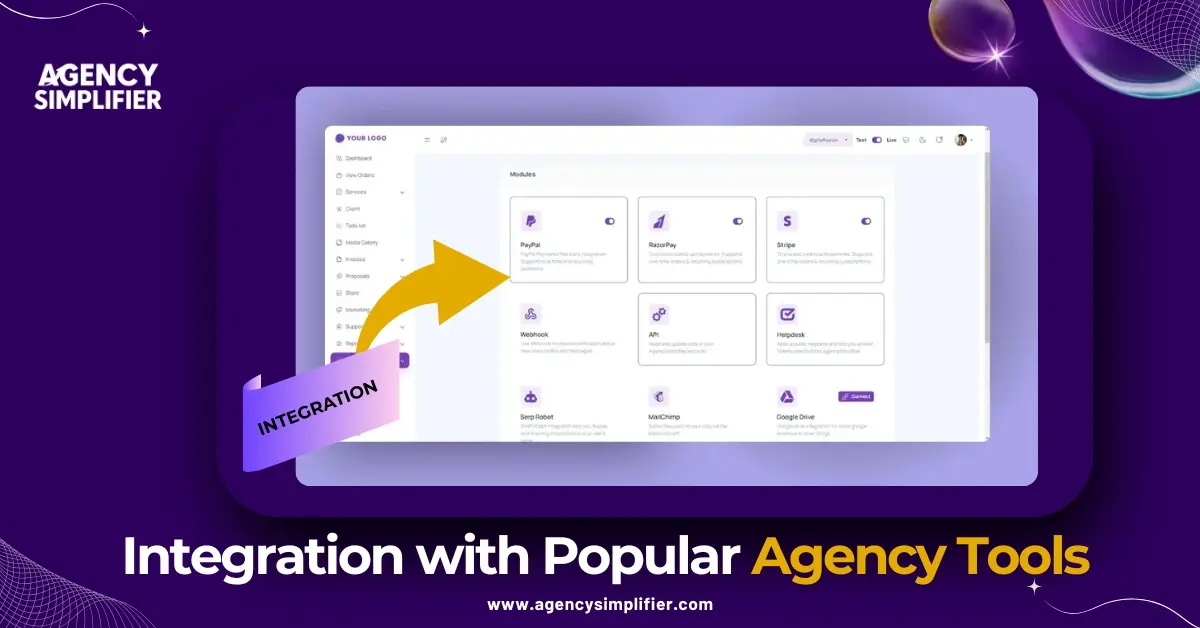
Agency Simplifier connects with the tools your team already uses, from communication platforms like Slack to file sharing with Google Drive and accounting with QuickBooks. Integrations are easy to set up, so you can keep your workflows connected and avoid double data entry.
This seamless connectivity means your agency can continue using best-in-class tools for each part of your business, all while centralizing information in one place. You save time, reduce errors, and ensure everyone is working from the same up-to-date data.
How It Compares to Workfront:
Agency Simplifier offers a more intuitive interface and faster onboarding, with features that align closely with agency operations. It provides transparent pricing and avoids the complexity often found in Workfront.
Free Trial: Available to test the platform without commitment.
2. Wrike
About: Wrike offers flexible project management with customizable workflows, real-time collaboration, and advanced reporting. Its robust feature set suits larger teams, but the interface and options can be overwhelming for agencies new to project management software.
Key Features:
- Task management and time tracking
- Gantt charts for scheduling
- Custom workflows and approvals
- File sharing and proofing tools
- AI-powered task prioritization
Who It’s For: Mid-sized to large agencies needing robust project planning and reporting.
Where It Lacks: Steep learning curve, slow page loads, and less intuitive for creative workflows.
3. Asana
About: Asana helps agencies organize work, set priorities, and meet deadlines with clear task lists and project timelines. Its intuitive interface supports team collaboration, although some advanced reporting and resource management features are only available on higher plans.
Key Features:
- Customizable project boards and lists
- Automation rules
- Calendar and workload views
- Portfolio and timeline management
- Integration with popular tools
Who It’s For: Teams seeking a user-friendly, scalable solution.
Where It Lacks: Advanced features are only available on higher-tier plans.
4. Monday.com
About: Monday.com provides a visual, easy-to-use platform for managing projects, tracking tasks, and automating workflows. Its customizable boards and integrations make it ideal for agencies seeking transparency and collaboration, though advanced features may require upgrades.
Key Features:
- Customizable workflows and dashboards
- Lead capture forms
- Automation for repetitive tasks
- Real-time performance metrics
- Integrations with CRM and marketing tools
Who It’s For: Agencies needing a flexible, visual platform.
Where It Lacks: Some features require advanced setup; costs can rise with add-ons.
5. ClickUp
About: ClickUp combines project management, docs, goals, and time tracking in one platform. Agencies appreciate its flexibility and extensive customization options, but the sheer number of features can lead to a learning curve for teams just starting out.
Key Features:
- Custom dashboards and views
- Checklists and templates
- Time tracking and billable hours
- Collaboration tools
- Advanced automation
Who It’s For: Agencies of any size wanting flexibility.
Where It Lacks: Requires customization; free plan is limited.
6. Smartsheet
About: Smartsheet brings spreadsheet-style project management to agencies, with automation, resource allocation, and reporting capabilities. It’s powerful for data-driven teams, but those unfamiliar with spreadsheets may find the interface less intuitive.
Key Features:
- Multiple project views (grid, Gantt, card)
- AI-powered automation
- Collaboration and proofing
- Advanced integrations
- Portfolio management
Who It’s For: Teams comfortable with spreadsheets and large projects.
Where It Lacks: Less visual and intuitive than some competitors.
7. Teamwork
About: Teamwork is designed for client service agencies, offering project templates, time tracking, and billing tools. Its client collaboration features stand out, but smaller agencies may find the interface a bit complex compared to more streamlined alternatives.
Key Features:
- Project and task management
- Time tracking and invoicing
- Client portal
- Collaboration tools
- Advanced reporting
Who It’s For: Agencies needing integrated billing and client management.
Where It Lacks: Interface can feel dated.
8. Productive (Productive.io)
About: Productive is an all-in-one agency management platform covering project management, resource planning, budgeting, and profitability tracking. Agencies can forecast revenue, automate billing, manage client portals, and access 50+ customizable reports in real time.
Key Features:
- Resource and capacity management
- Budgeting and profitability tracking
- Time tracking
- Project and task management
- Integrations
Who It’s For: Agencies focused on financial performance.
Where It Lacks: Some features require custom setup.
9. Mavenlink
About: Mavenlink specializes in professional services automation, offering advanced resource management, project execution, and financial tracking. Its tools help agencies optimize staffing, control budgets, and improve project delivery across distributed teams.
Key Features:
- Resource planning and forecasting
- Project accounting
- Collaboration tools
- Business intelligence reporting
- Integration with financial systems
Who It’s For: Agencies and service firms managing complex projects.
Where It Lacks: Higher learning curve.
10. Jira Align
About: Jira Align is built for large, agile agencies that need portfolio management and cross-team coordination. It connects strategy to execution, offering real-time visibility, agile planning, and reporting for organizations managing complex, multi-team projects.
Key Features:
- Enterprise agile planning
- Portfolio and program management
- Real-time reporting
- Integration with Jira and other tools
- Custom workflows
Who It’s For: Large agencies with complex, agile workflows.
Where It Lacks: Too complex for small or mid-sized agencies.
Feature Comparison Matrix
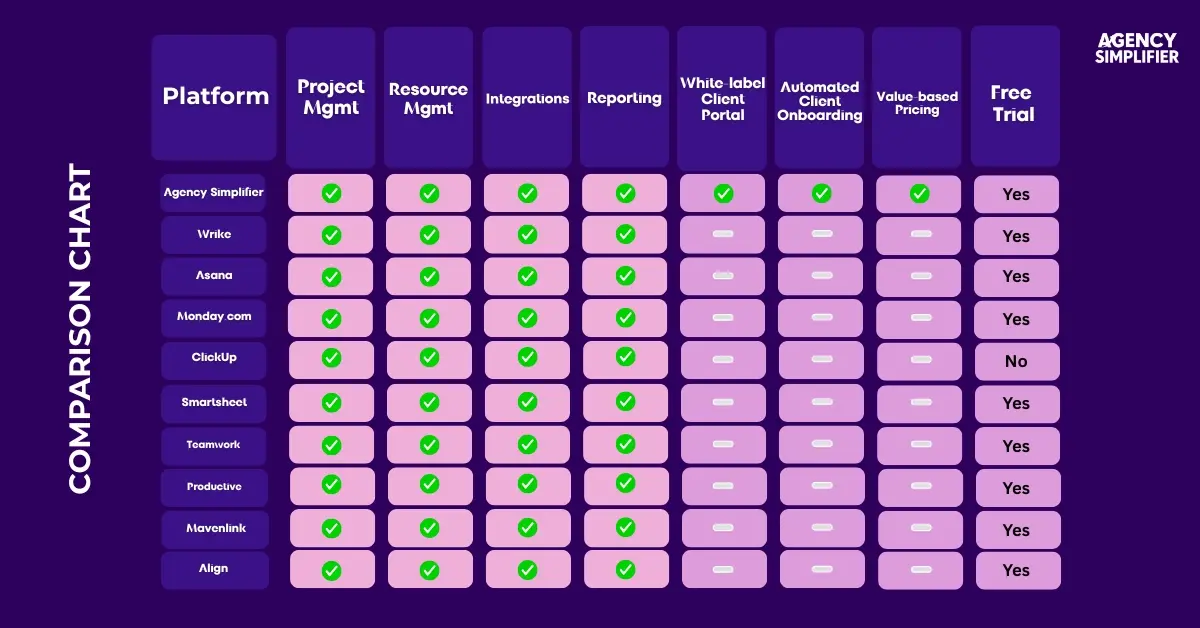
How to Choose the Right Workfront Alternative
Step 1: Consider your agency’s size, workflow complexity, and growth plans
Step 2: Prioritize the features and integrations you need most
Step 3: Evaluate user experience and customer support
Step 4: Compare pricing and scalability
Step 5: Use free trials to test which platform fits your team best
Conclusion
Choosing the right project management tool is crucial for your agency’s success. While Workfront offers powerful features, it may not fit every agency’s needs. The alternatives listed here provide a range of options that are easier to use, more affordable, and better suited to creative and marketing workflows.
Agency Simplifier stands out for its agency-focused design, simple onboarding, and transparent pricing. Try it free to see if it fits your team.
If you have questions or want personalized advice, feel free to reach out.
Frequently Asked Questions
Q1. What is the best Workfront alternative for agencies?
Ans: It depends on your agency’s needs, but Agency Simplifier, Wrike, and Monday.com are popular for their flexibility and features.
Q2. Which platform offers the best value for small teams?
Ans: ClickUp and Asana are affordable and easy to use for small teams.
Q3. Are there free alternatives to Workfront?
Ans: Agency Simplifier, ClickUp and Asana offer free plans, though with some limitations.
Q4. Can I migrate data easily from Workfront to another platform?
Ans: Most platforms support data import from Workfront through export files or migration tools. The ease depends on your data complexity and the new platform’s capabilities. It’s best to check with your chosen tool for specific migration options and support.
Shripad Deshmukh
Shripad Deshmukh, founder of Agency Simplifier, brings over 15 years of experience in custom SaaS development and product management. With a strong focus on digital transformation and multi-platform customer experiences.